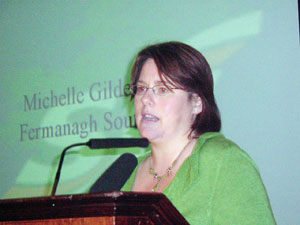2 November 2006 Edition
All Ireland conference - Wide range of organisations represented

Bridging the border
Partition has been an unmitigated disaster for all the people of this island Sinn Fein President Gerry Adams told a packed conference hall in Newry last week.
The conference Building an Integrated Future for the Border Region was organised by Sinn Féin's All Ireland group and included representatives from a wide range of organisations working in cross border initiatives.
Amongst the speakers was Chief Executive of the Irish Central Border Area Network, Kate Burns, Dr Patricia Clarke, Research Manager for the Centre for Cross Border Studies and the Director of the International Centre for Local and Regional Development, John Driscoll.
John Driscoll outlined cross border co-operation along the Quebec-New York economic corridor. A number of speakers identified the key drivers behind cross border initiatives as local and regional with those higher within the state hierarchy more resistant to change. Driscoll used his knowledge of cross border co-operation between the US and Canada to highlight the possibilities and practical advantages to development such initiatives can accrue.
Patricia Clarke detailed the key role of cross border research and the importance of generating data appropriate to the task. CCBS are currently developing an evidence base for all-island co-operation by analysing the Border Ireland dataset and reporting on North-South Common Chapter activity, as well as carrying out comparative East-West research and collaborative research involving seven EU countries.
Mary Mulvey from Greenbox which promotes sustainable tourism, Wesley Best of STEM an environmental group which works to improve the practices of local councils and businesses both sides of the border and Colm Donaghy from CAWT, a cross border organisation with representatives from the Health Boards immediately north and south of the border provided practical illustrations of cross border co-operation.
The conference was also addressed by Jens Gabbe, General Secretary of the Association of European Borer Regions, Fernando Jose Coelho Moniz of the EU Commissions Territorial Co operation Unit and Shaun Henry from the Special EU Programmes Body with responsibility for the implementation of Peace 11 and INTERREG IIIA.
In an upbeat address to the conference Kate Burns explained that the North West Region Cross Border Group, the Irish Central Border Area Network and the East Border Region Committee are made up of local government representatives on both sides of the border together with an equal number of social partners to form INTERREG IIIA partnerships.
"Supporting regeneration of the border region through a combined development-led approach of EU funding and lobbying, the three Cross Border Partnerships are a success story of cross border co-operation. Despite the challenges of the wider issue of North-South co-operation, the partnerships have enjoyed enormous success and had collectively levered more than €56 million by the end of 2005", said Burns.
Outlining the barriers to development, Burns highlighted the lack of data and cross border strategic planning. "Overall cross border efforts lack strategy, direction, policy and planning and as such the efforts to date have been shallow and will not deliver the result we need", she said.
"When different jurisdictions develop a whole set of operational arrangements in isolation from each other over a long number of years, institutionalised division becomes very deeply embedded", said Burns.
The cross border agenda is largely determined by the Six County Civil Service, she argued and the lack of democratic accountable structures of governance in the North encourage stagnation and timidity.
On the Southern side, regional and local government is very centralised. Cross border development is always better served by strong local and regional government.
Sinn Féin MP for Fermanagh/South Tyrone, Michelle Gildernew argued that the discrimination that has underpinned regional development in Ireland is compounded and stimulated by the existence of the border.
"Social, economic and spatial deprivation brought about by the dislocating resonance of the border impacts detrimentally on the life chance of the people who live adjacent to it", said Gildernew.
"The concentration of wealth, economic opportunity, administrative control and social development within the Dublin and Belfast metropolitan areas is clearly influenced by spatial regionalism. And that represents a denial of human rights.
"The communities who live within the Border Corridor Area share a debilitating interdependence in that they suffer from similar types of social, economic and spatial deprivation brought about by living in close proximity to the border", said Gildernew.
The institutionalisation of the all-Ireland agenda emerging out of the Good Friday Agreement had legitimised and opened the floodgates of all Ireland activity, she argued.
"In October 2003 Sinn Féin launched its policy document Reunification through Planned Reintegration. We then spent the next three years working, consulting and debating with others to action these points while developing additional ideas and initiatives. We have had a fair degree of success but there is significant room for improvement", said Gildernew.
"Regional and local government, implementation bodies, cross border corridor groups, developing agencies, the community sector and business sectors are now forging ahead. Sinn Féin has a contribution to make but we do not have all the answers, we never pretended we did."
Six years after their original commitment to develop the Letterkenny-Derry Gateway, the Dublin and British governments have recently launched their North West Gateway Initiative with a view to developing an integrated spatial development plan for the north west of the island.
"But at the moment this plan is non statutory and government agencies are under no direct obligation to implement it. So despite an extensive consultation at the end of the process it might not be worth the paper it's written on, said Gildernew.
"The 100 billion to be spent in all Ireland infrastructure by both governments over the next ten years should have a significant portion of that invested in the border corridor area. Lets define and cost our complete infrastructure needs for the entire border region and hand it over to the two governments so they know where to spend our money. Lets see if they fit the bill", said Gildernew.


